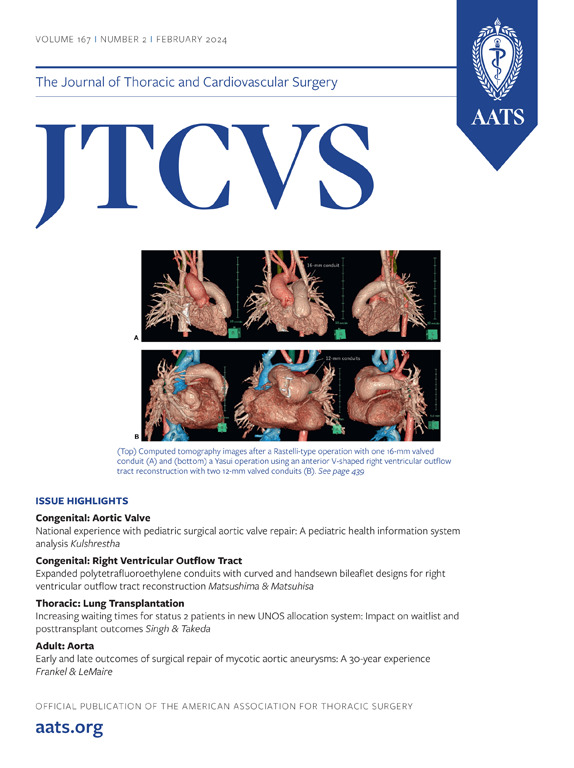主动脉手术后结构化随访成像的实用性
IF 4.9
1区 医学
Q1 CARDIAC & CARDIOVASCULAR SYSTEMS
Journal of Thoracic and Cardiovascular Surgery
Pub Date : 2025-02-01
DOI:10.1016/j.jtcvs.2024.02.007
引用次数: 0
摘要
背景:虽然主动脉手术后的术后随访是指南所推荐的,但其临床效用并没有得到充分的证实。我们假设,主动脉手术后进行结构化随访成像可改善预后。我们随后记录了无症状术后成像的放射学发现:方法:纳入2017年1月至2021年7月期间所有开胸主动脉手术后存活至出院的患者,不包括心内膜炎患者。将在本中心接受随访并按计划接受造影检查的患者与未接受造影检查的患者进行比较。生存率采用卡普兰和梅耶尔法进行分析,再介入采用Fine-Gray亚危险函数进行评估。常规成像检查包括主动脉生长、假性动脉瘤和移植物周围密度:主动脉手术后,术后 3 年的累计随访率为 38.6%。接受随访的患者更有可能出现夹层,合并症较少,但在社会经济因素和医院距离方面相似。经过配对并考虑不死时间偏差后,随访患者的再介入率更高(26.0% 对 9.0%),四年后的存活率相似(98.7% 对 95.2%,P=0.110)。三年后,假性动脉瘤、移植物周围密度明显增加以及常规成像结果增长≥3毫米/年的累积发生率为49.7%:结论:主动脉项目实施结构化随访成像的临床依从性较低。随访与主动脉再介入率增加有关。临床相关的放射学发现在无症状成像中很常见,并且在整个五年随访期间都在增加,而不是在术后早期趋于平稳。本文章由计算机程序翻译,如有差异,请以英文原文为准。
Utility of structured follow-up imaging after aortic surgery
Background
Although postoperative follow-up after aortic surgery is recommended by guidelines, its clinical utility is not well documented. We hypothesized that structured follow-up imaging by an aortic program would improve outcomes. We then documented radiologic findings on asymptomatic postoperative imaging.
Methods
All patients who survived to discharge after open thoracic aortic surgery between January 2017 and July 2021 were included, excluding endocarditis. Patients who followed at our center and received scheduled imaging were compared with patients who did not. Survival was analyzed by the method of Kaplan–Meier, and reintervention was assessed using the Fine–Gray subhazard function. Routine imaging was reviewed for aortic growth, pseudoaneurysm, and perigraft density.
Results
After aortic surgery, the cumulative incidence of follow-up was 38.6% at 3 years postoperatively. Patients with follow-up were more likely to have a dissection and fewer comorbidities but were similar in regards to socioeconomic factors and distance to hospital. After matching and accounting for immortal time bias, patients with follow-up had a greater reintervention rate (26.0% vs 9.0%) with similar survival (98.7% vs 95.2%, P = .110) at 4 years. The cumulative incidence of pseudoaneurysm, significant perigraft density, and growth ≥3 mm/year on routine imaging was 49.7% at 3 years.
Conclusions
Implementation of structured follow-up imaging by an aortic program resulted in low clinical compliance. Follow-up was associated with increased rates of aortic reintervention. Clinically relevant radiologic findings were common on asymptomatic imaging and increased throughout 5-year follow-up rather than plateauing in the early postoperative period.
求助全文
通过发布文献求助,成功后即可免费获取论文全文。
去求助
来源期刊
CiteScore
11.20
自引率
10.00%
发文量
1079
审稿时长
68 days
期刊介绍:
The Journal of Thoracic and Cardiovascular Surgery presents original, peer-reviewed articles on diseases of the heart, great vessels, lungs and thorax with emphasis on surgical interventions. An official publication of The American Association for Thoracic Surgery and The Western Thoracic Surgical Association, the Journal focuses on techniques and developments in acquired cardiac surgery, congenital cardiac repair, thoracic procedures, heart and lung transplantation, mechanical circulatory support and other procedures.

 求助内容:
求助内容: 应助结果提醒方式:
应助结果提醒方式:


